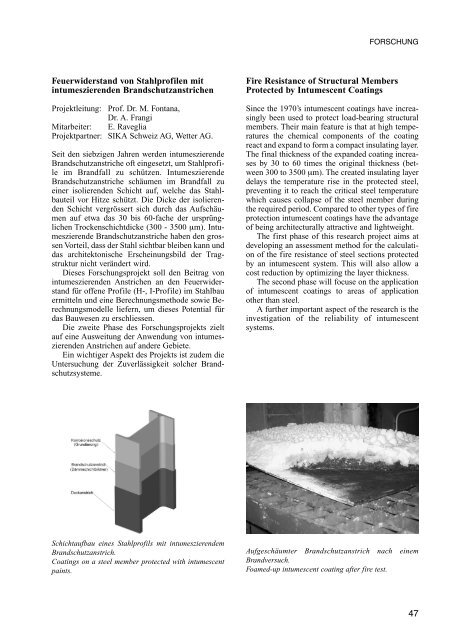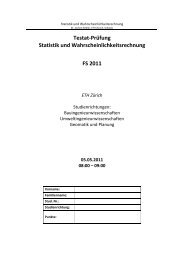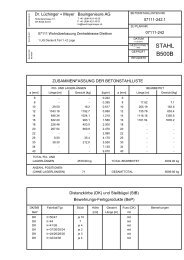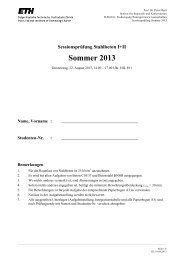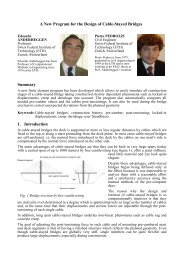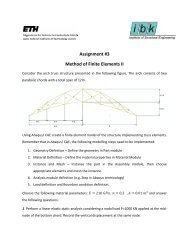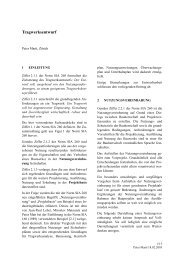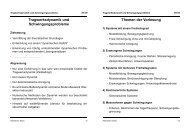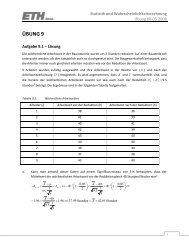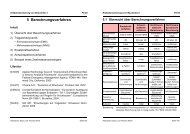IBK Jahresbericht 2004-2006 - Institut für Baustatik und Konstruktion ...
IBK Jahresbericht 2004-2006 - Institut für Baustatik und Konstruktion ...
IBK Jahresbericht 2004-2006 - Institut für Baustatik und Konstruktion ...
Erfolgreiche ePaper selbst erstellen
Machen Sie aus Ihren PDF Publikationen ein blätterbares Flipbook mit unserer einzigartigen Google optimierten e-Paper Software.
FORSCHUNG<br />
Feuerwiderstand von Stahlprofilen mit<br />
intumeszierenden Brandschutzanstrichen<br />
Projektleitung: Prof. Dr. M. Fontana,<br />
Dr. A. Frangi<br />
Mitarbeiter: E. Raveglia<br />
Projektpartner: SIKA Schweiz AG, Wetter AG.<br />
Seit den siebzigen Jahren werden intumeszierende<br />
Brandschutzanstriche oft eingesetzt, um Stahlprofile<br />
im Brandfall zu schützen. Intumeszierende<br />
Brandschutzanstriche schäumen im Brandfall zu<br />
einer isolierenden Schicht auf, welche das Stahlbauteil<br />
vor Hitze schützt. Die Dicke der isolierenden<br />
Schicht vergrössert sich durch das Aufschäumen<br />
auf etwa das 30 bis 60-fache der ursprünglichen<br />
Trockenschichtdicke (300 - 3500 μm). Intumeszierende<br />
Brandschutzanstriche haben den grossen<br />
Vorteil, dass der Stahl sichtbar bleiben kann <strong>und</strong><br />
das architektonische Erscheinungsbild der Tragstruktur<br />
nicht verändert wird.<br />
Dieses Forschungsprojekt soll den Beitrag von<br />
intumeszierenden Anstrichen an den Feuerwiderstand<br />
<strong>für</strong> offene Profile (H-, I-Profile) im Stahlbau<br />
ermitteln <strong>und</strong> eine Berechnungsmethode sowie Berechnungsmodelle<br />
liefern, um dieses Potential <strong>für</strong><br />
das Bauwesen zu erschliessen.<br />
Die zweite Phase des Forschungsprojekts zielt<br />
auf eine Ausweitung der Anwendung von intumeszierenden<br />
Anstrichen auf andere Gebiete.<br />
Ein wichtiger Aspekt des Projekts ist zudem die<br />
Untersuchung der Zuverlässigkeit solcher Brandschutzsysteme.<br />
Fire Resistance of Structural Members<br />
Protected by Intumescent Coatings<br />
Since the 1970’s intumescent coatings have increasingly<br />
been used to protect load-bearing structural<br />
members. Their main feature is that at high temperatures<br />
the chemical components of the coating<br />
react and expand to form a compact insulating layer.<br />
The final thickness of the expanded coating increases<br />
by 30 to 60 times the original thickness (between<br />
300 to 3500 μm). The created insulating layer<br />
delays the temperature rise in the protected steel,<br />
preventing it to reach the critical steel temperature<br />
which causes collapse of the steel member during<br />
the required period. Compared to other types of fire<br />
protection intumescent coatings have the advantage<br />
of being architecturally attractive and lightweight.<br />
The first phase of this research project aims at<br />
developing an assessment method for the calculation<br />
of the fire resistance of steel sections protected<br />
by an intumescent system. This will also allow a<br />
cost reduction by optimizing the layer thickness.<br />
The second phase will focuse on the application<br />
of intumescent coatings to areas of application<br />
other than steel.<br />
A further important aspect of the research is the<br />
investigation of the reliability of intumescent<br />
systems.<br />
Schichtaufbau eines Stahlprofils mit intumeszierendem<br />
Brandschutzanstrich.<br />
Coatings on a steel member protected with intumescent<br />
paints.<br />
Aufgeschäumter Brandschutzanstrich nach einem<br />
Brandversuch.<br />
Foamed-up intumescent coating after fire test.<br />
47


